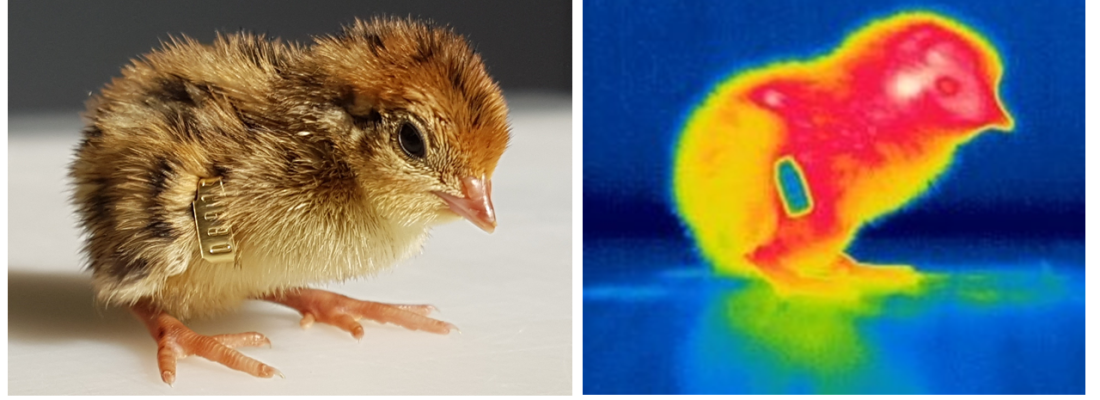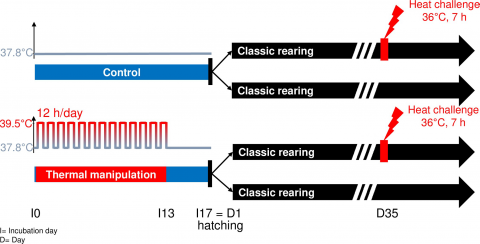Biodiversity Reading time 6 min
The incubation temperature of Japanese quail eggs as a lever to improve heat resistance?
Published on 17 November 2020

In vertebrates, variations in the embryonic environment can affect the development, phenotype and health of individuals. For example, it has been shown that chickens exposed to cyclic temperature increases during the egg incubation phase (i.e. during embryogenesis) are more resistant to heat at 35 days of age. Metabolic, physiological and molecular changes induced by this embryonic treatment have also been demonstrated (Loyau et al., 2013-2016; David et al., 2019).
The Japanese quail (Coturnix japonica) is an avian species closely related to the chicken. It is of both scientific interest (especially for developmental biology studies) and agronomic interest for meat and egg production. However, the effects of temperature during incubation on the physiology, metabolism and heat resistance of this species have never been characterized in an integrative manner. For this purpose, the researchers transposed the protocol developed in chicken to Japanese quail, cyclically (12h/day) increasing the egg incubation temperature by 1.7°C (i.e. 39.5°C instead of the usual 37.8°C) from day 1 to day 13 of egg incubation. The heat tolerance of quails was tested by a heat challenge of 36°C for 7 hours at the age of 35 days. Numerous zootechnical (e.g. weight), physiological (e.g. temperature, hormones in the blood) and metabolic (e.g. blood biochemical parameters) parameters were measured throughout the quail rearing. For each parameter measured, the effects of sex, embryonic treatment and thermal challenge were studied.

The results of this study show that the cyclic increase in incubation temperature modified the growth of quails, with heavier animals at hatching and lighter ones at the age of 25 days. These differences were no longer observable 35 days after hatching. Body surface temperatures, used as markers of internal temperature or heat dissipation capacities depending on the areas studied, were measured by infrared thermography. Analysis of the results showed that the heat treatment decreased the surface temperature of the legs in females, suggesting possible modulation of blood flow. Beak surface temperature was also affected by the embryonic treatment in response to a heat challenge at 35 days of age, in different ways according to sex, also suggesting changes in the quail's heat dissipation potential. In addition, the embryonic treatment had a positive impact on the partial blood pressure and the percentage of oxygen saturation for 35 days-old females, reinforcing the hypothesis of an adaptation of the respiratory physiology of these animals.
This first characterization of temperature increase during incubation in Japanese quail thus showed lasting changes in growth, physiology and metabolism of the birds, with variable effects according to sex. Researchers now aim to understand the molecular mechanisms, particularly epigenetic (affecting gene expression in a dynamic and reversible manner), that could explain these long-term changes induced by this early exposure to temperature increases. In addition, the possible transgenerational transmission of the effects of the treatment on the descending generations is also being studied.
Vitorino Carvalho, A.; Hennequet-Antier, C.; Crochet, S.; Bordeau, T.; Courousse, N.; Cailleau-Audouin, E.; Chartrin, P.; Darras, V.M.; Zerjal, T.; Collin, A.; Coustham, V., 2020. Embryonic thermal manipulation has short and long-term effects on the development and the physiology of the Japanese quail. Plos One, 15 (1): 20. http://dx.doi.org/10.1371/journal.pone.0227700
Other references:
Loyau, T.; Berri, C.; Bedrani, L.; Métayer-Coustard, S.; Praud, C.; Duclos, M. J.; Tesseraud, S.; Rideau, N.; Everaert, N.; Yahav, S.; Mignon-Grasteau, S.; Collin, A., 2013. Thermal manipulation of the embryo modifies the physiology and body composition of broiler chickens reared in floor pens without affecting breast meat processing quality. J Anim Sci, 91(8):3674-85. doi: 10.2527/jas.2013-6445
Loyau, T.; Hennequet-Antier, C.; Coustham, V.; Berri, C.; Leduc, M.; Crochet, S.; Sannier, M.; Duclos, M.J.; Mignon-Grasteau, S.; Tesseraud, S.; Brionne, A.; Métayer-Coustard, S.; Moroldo, M.; Lecardonnel, J.; Martin, P.; Lagarrigue, S.; Yahav, S.; Collin, A., 2016. Thermal manipulation of the chicken embryo triggers differential gene expression in response to a later heat challenge. BMC Genomics, 17:329. doi: 10.1186/s12864-016-2661-y
David, S.-A.; Vitorino Carvalho, A.; Gimonnet, C.; Brionne, A.; Hennequet-Antier, C.; Piégu, B.; Crochet, S.; Couroussé, N.; Bordeau, T.; Bigot, Y.; Collin, A.; Coustham, V., 2019. Thermal Manipulation During Embryogenesis Impacts H3K4me3 and H3K27me3 Histone Marks in Chicken Hypothalamus. Front Genet, 10:1207. doi: 10.3389/fgene.2019.01207
